
A view down the photodetachment chamber
Current research
Astrochemistry (neutral-cation collisions)
Understanding the evolutionary pathway of baryonic matter from prestellar cores to the formation of a planetary system around a host star lies at the forefront of present day astrophysical research. Important steps along this pathway include prestellar cores and protoplanetary disks. Observations of deuterated molecules are used to trace the properties of these objects, yielding information about the temperature, density, chemistry, abundances, ionization level, evolutionary stage, and thermal history of the media. For the very dense cold regions found in prestellar cores and in the outer midplane of protoplanetary disks, most molecules bearing heavy elements freeze onto dust grains, except for hydrogen molecules, neutral and ionized. HD remains in the gas phase and becomes the primary deuterium reservoir. HD can deuterate H3+, sequentially leading to D3+ via a series of barrierless, exoergic isotope-exchange reactions. The resulting deuterium fractionation of the H3+ isotopologues is passed on to other gas-phase species through subsequent ion-neutral reactions. Of particular importance is the formation of N2D+ and N2H+, which occurs at physical locations near the N2 snow line in prestellar cores and protoplanetary disks. These two ions are commonly used to trace out the properties of these objects. However, reliably interpreting the N2D+ and N2H+ observations hinges on accurately understanding the reaction of N2 with the H3+ isotopologues that forms these two ions.
We will measure the integral cross sections (ICSs) for the reactions: (1) N2 + H3+ → N2H+ + H2, (2) N2 + H2D+ → N2H+ + HD, (3) N2 + H2D+ → N2D+ + H2, (4) N2 + D2H+ → N2H+ + D2, (5) N2 + D2H+ → N2D+ + HD, and (6) N2 + D3+ → N2D+ + D2. Using our dual-source, ion-neutral, merged-fast-beams apparatus, we will generate the ICS data to an accuracy of ~ 15%. ICS measurements will be performed as a function of the internal temperatures of the reactants. From these results we will generate thermal rate coefficients for use in astrochemical models. Our results will also help to guide the development of deuterated astrochemical models when reaction kinetic data do not exist for the D-bearing species. Two approaches have been proposed to scale the available kinetics data for reactions with an H-bearing molecule to reactions with partially to fully deuterated isotopologues. Our measurements will help to determine which, if either, of these approximations is valid. Moreover, in order to generate astrochemical models with partially deuterated isotopologues, complete scrambling of the reaction complex is usually assumed and statistical branching ratios are used for the relative fractions of H-bearing and D-bearing daughter products. Our measurements will help to determine the validity of this approximation.
This research on our D3 apparatus is supported by NSF grant AST-2002461. Previous research projects using the D3 apparatus were supported by the NSF grants AST-1613267 and AST-0905832.
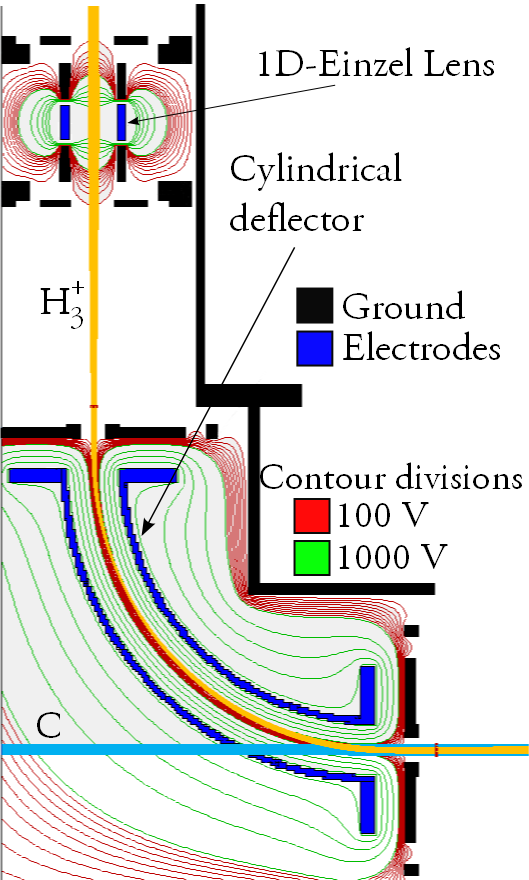
Beam merger simulation for the D3 apparatus.
Astrochemistry (electron-cation collisions)
With support from NASA, we are advancing our understanding of how diffuse atomic clouds transition to diffuse molecular clouds, an important first step in the star formation process. Observing this transition is challenging as H2 lacks a permanent dipole moment, making direct detections extremely difficult. Also, the commonly used H2-surrogate CO is readily photodissociated in diffuse clouds. We will improve the community's ability to use OH+, HCl+, and ArH+ to trace out the astrophysical properties of this transition. These molecules enable us to measure in diffuse clouds the cosmic ray ionization rate of atomic H, to infer the molecular hydrogen fraction, to constrain the far-ultraviolet interstellar radiation field, and to use proxies to trace out the difficult-to-detect H2 molecule and infer H2 column densities and masses.
Using OH+, HCl+, and ArH+ to trace out the properties of diffuse clouds requires an accurate understanding of the underlying gas-phase astrochemistry controlling the abundances of these molecules. Key to this are reliable rate coefficients for dissociative recombination (DR) of electrons with OH+, HCl+, and ArH+. Accurate quantum mechanical calculations are lacking due to the theoretical and computational challenges of handling the many-body systems and the infinite number of intermediate states involved. Laboratory measurements are the only reliable means to generate the needed DR data. But previous experimental work is of limited use due to the moderate to high levels of internal excitation of the molecular cations (typically ~300-1000 K), which is much hotter than diffuse cloud temperatures.
We will carry out the first DR measurements for OH+, HCl+, and ArH+ with internal excitations of ~10 K, generate DR data suitable for astrochemistry, incorporate these data into diffuse cloud models, and investigate the astrophysical implications of our new chemical data. The DR measurements will be carried out using the recently commissioned heavy ion Cryogenic Storage Ring (CSR) which is located at the Max Planck Institute for Nuclear Physics (MPIK) in Heidelberg, Germany. No other facility in the world is capable of carrying out the proposed DR measurements. Furthermore, we will investigate the astrophysical implications of our new DR data using astrochemical models which we have developed to interpret diffuse cloud observations.
This research is supported by NASA grant 80NSSC19K0696. Previous research in electron-driven astrochemistry was supported by NASA grants NNX15AL73G and NNX12AE25G.
With support from the NSF, we are studying additional aspects of how diffuse atomic clouds transition to diffuse molecular clouds, an important early step in the star formation process. To this end, we will improve the community's ability to characterize cold diffuse gas using CF+ to constrain the far-ultraviolet interstellar radiation field (ISRF) and as a proxy to trace out the difficult-to-detect H2 molecule. Additionally, we will improve the community's ability to use CH+ and SH+ to infer the injection of mechanical energy into the diffuse interstellar medium (ISM), and thereby study the dynamics of diffuse clouds. For this, we will measure a key chemical reaction controling the abundances of these three ions in diffuse clouds, namely dissociative recombination (DR). Reliable DR data will enable observers to answer the astrophysical questions: (1) What is the intensity of the ISRF from observations of CF+? (2) What is the CF+-to-H2 conversion factor, taking into account all reservoirs of F? and (3) How much and where is mechanical energy input into the diffuse ISM? The laboratory DR studies will be performed using the Cryogenic Storage Ring (CSR) located at the Max Planck Institute for Nuclear Physics in Heidelberg, Germany. CSR can store ions for over 1,000 s, enabling the internal excitation of the stored ions to radiatively cool to levels comparable to diffuse cloud conditions. Recent CSR DR results for HeH+ have found that previous room-temperature storage ring results can be off by nearly an order of magnitude and that stateof- the-art theory can be off by up to a factor of ~25. Using the CSR DR measurements, we will generate thermal DR rate coefficients for temperatures as low as ~10 K, with an expected accuracy of ~15%.
This research is supported by NSF grant AST-1907188. Previous research in electron-driven astrochemistry was supported by NSF grants AST-1107036 and AST-0807436.

The Cryogenic Storage Ring (CSR) at the Max Planck Institute für Kernphysik in Heidelberg, Germany.
The Impact of Solar Wind Ions on the Surface and Exosphere of Mercury
Our objective is to improve the interpretation of in-situ and remote-sensing data of Mercury's surface and exosphere. To achieve this, our interdisciplinary team will update their exosphere and spectrophotometric models by incorporating new data from our experimental simulations of solar wind ion irradiation using analogs for Mercury's regolith and our laboratory-benchmarked theoretical calculations. Current exosphere and spectrophotometric surface models make simplified assumptions about sputter yields and spectral changes from ion irradiation, largely due to the lack of measurements for regolith-like loose powders. We will perform ion-irradiation studies on regolith-like loose powders and provide quantitative data for the corresponding sputter yields and spectral changes. We will use our sputter yield data to benchmark new theoretical sputter yield calculations. We will incorporate our new experimental and theoretical data into our exosphere and spectrophotometric models and reinterpret archival MESSENGER data of Mercury. Specific science questions to be addressed include: (1) What role do solar wind ions play in the formation of Mercury's sodium exosphere? (2) What fraction of the sputtered Na returns to the surface and what fraction escapes to space? (3) How do solar wind ions affect the spectrophotometric properties of Hermean minerals? (4) How do the measured ion-generated spectrophotometric changes compare to the observed distribution of Mercury's spectrophotometric properties?
The approach and methodology for the lab work will be to use our novel ion-beam-line configuration to irradiate regolith-like loose powders from above at zenith angles of 45 degrees, developed with our expiring SSW funding. We will irradiate the samples with ion beams of H and He at typical solar wind energies of 1 keV/amu. Sputter yields will be measured using catcher foils surrounding the sample. The foils will be analyzed ex-situ using a quartz crystal microbalance and synchrotron-based X-ray photoelectron spectroscopy. We will also perform in situ 350-2500 nm spectroscopic analyses for a range of incident and emergent angles spanning -45 to +45 degrees and covering phase angles between the incident and emergent light from 5 to 90 degrees. The spectral analysis will be in vacuo and in-situ, as loose powders cannot be transported and measured ex situ without overturning the irradiated surfaces. For our exosphere studies, we will use our Monte Carlo model developed with our expiring SSW funding. We will compare the model results with MESSENGER MASCS data, including high latitude data where a sputter signature is expected to manifest itself. The model results will be scaled until a match is found. We will update the current model with our experimental and theoretical results for the needed sputter yields and angular distributions. In addition, we will run the models with the best current estimated cusp positions and areas feeding the ions to the surface and using the measured ion fluxes and energies to the surface from the MESSENGER FIPS data. For the spectrophotometric surface studies, we will reinterpret the archival data using three commonly used space-weathering metrics: one based on lunar analyses, another on asteroid studies, and the third on Mercury color imaging. We will calculate these metrics using the MESSENGER MDIS and MASCS data. We will use our laboratory benchmarking of these metrics to explore the role that solar wind ions play in determining the spectrophotometric properties of Mercury.
This research is supported by NASA grant number pending and was previously supported by NASA grant 80NSSC18K0521.
The Savin Group's novel apparatus for ion-irradiation regolith-like loose powders.
Atomic physics studies for solar physics
Fe IX emission forms some of the most powerful spectroscopic diagnostics for solar physics. Fe IX, like Fe XVII, is a closed shell system that is formed over a broad range of temperatures and probes many solar structures. Its peak formation temperature is at the boundary between the transition region and the corona, making Fe IX a critical ion for understanding energy and mass flow into the corona. Unlike Fe XVII however, the Fe IX spectrum suffers from many unknown lines and uncertain atomic data.
To analyze the spectra it is necessary to know the wavelengths and transitions associated with all the spectral lines. Unidentified lines impede the analysis by blending with other lines leading to erroenous interpretations of the data and by not permitting the analysis to make full use of all the diagnostic information available.
We propose to resolve these issues for Fe IX, thereby enabling us to harness the full diagnostic power of Fe IX and maximize the scientific return of current and future NASA heliophysics missions. We will unambiguously identify Fe IX lines in the wavelength range 160-300 Angstroms. This is the bandpass relevant to the Extreme Ultraviolet Imaging Spectrometer (EIS) on Hinode and it is also observed by sounding rockets and planned for future missions.
Fe IX line intensity ratios can be used to as electron density diagnostics for solar observations. In fact, the Fe IX 244.91/241.74 is one of the best density diagnostics in the solar spectrum. But the calibrations are very uncertain. Density diagnostic line ratios are sensitive to uncertainties in the atomic data because they depend on many factors, such as collisional excitation and de-excitation, radiative transitions, and cascades. Observational analyses imply density uncertainties from the atomic data of factors of 2-10.
We propose to calibrate Fe IX density diagnostic ratios in the laboratory. In previous work, we have developed techniques that allow us to make calibrations accurate to better than 20%. These are the most accurate laboratory calibrations obtained anywhere to date.
We will use the electron beam ion trap (EBIT) at Lawrence Livermore National Laboratory (LLNL). This is a cylindrical device with an electron beam running down the axis of the trap. Gas is introduced into the trap and ionized by collisions with the electron beam. The ions are trapped by axial electrodes, an axial magnetic field, and by the radial electric potential of the beam. Collisions also excite the ions and the subsequent emission is measured by spectrometers.
The line surveys will be performed by varying the electron beam energy. As the beam energy is increased, the ions become more highly charged. By measuring the spectrum while varying the beam energy in steps, all the various emission lines can be unambiguously associated with their emitting charge state.
Density diagnostic calibrations are obtained by varying the electron beam current, which changes the electron density in the trap. We measure the spectrum for different densities and thereby obtain an empirical calibration for the line intensity ratio vs. density. Experimentally, we work with the effective density, which depends on the overlap between the electron beam and ion cloud. We have developed methods to measure the ion cloud and accurately determine the effective density. We can reach densities in the range of 1E10-1E12/cm3 that are directly relevant to the solar corona.
This research is supported by NASA grant 80NSSC20K0916 and was previously supported by NASA grant 80NSSC18K0521.
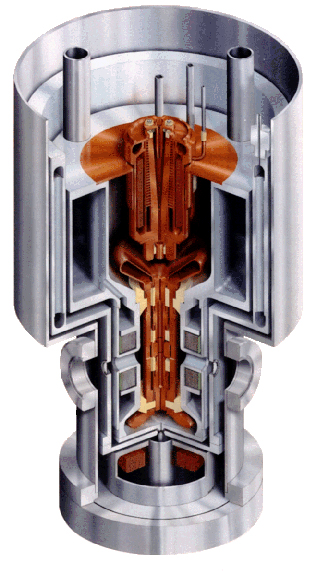
Cut-away view of LLNL EBIT.
Plasma physics simulations of the solar wind (Hahn-led)
Alfvén waves are a type of plasma wave in which the oscillations are mainly transverse to the background magnetic field. These waves travel near the Alfvén speed, which is proportional to the magnetic field strength and inversely proportional to the square root of the plasma density.
Alfvén waves are important in natural systems and are fundamental in basic plasma physics. In inhomogeneous plasmas Alfvén waves undergo reflection, phase mixing, and damping. These processes are believed to be especially important for heating the solar corona. We propose novel experiments to understand the propagation of Alfvén waves in inhomogeneous plasmas, using the Large Plasma Device (LAPD) which is part of the Basic Plasma Science Facility located at the University of California Los Angeles.
We will focus on two classes of inhomogeneity: gradients in the Alfvén speed parallel to the ambient magnetic field and perpendicular to the field. Theory predicts that parallel gradients in the Alfvén speed reflect Alfvén waves. But, our previous experiments on LAPD observed no such reflection, although wave power transmission through the gradient was greatly reduced. This lack of reflection contradicts the basic theory. Here, we propose new experiments designed to explain this surprising lack of reflection.
We will determine whether enhanced Landau damping in the parallel gradient rapidly damps the Alfvén waves. Landau damping occurs through the interaction of the wave fields with particles that have a velocity at that of the wave. Landau damping is large when the Alfvén speed is roughly the same as the electron thermal speed. We propose to reduce Landau damping by making the Alfvén speed both much smaller and much greater than the electron thermal speed. Experimentally, this will be accomplished by varying the fill gas, magnetic field strength, and electron temperature.
A second explanation for the lack of reflection is that it takes time and energy to set up the boundary layer currents in the plasma that generate the reflected waves. Initially wave energy goes into driving these currents and then reflection occurs later. We will test this possibility by exciting long wave trains and observing whether the reflectance changes over time.
In perpendicular gradients, Alfvén waves on neighboring field lines travel at different phase velocities and the wave fronts become distorted. This is known as phase mixing and the distortion is characterized by wave power spreading to larger perpendicular wavenumbers (k-perp), or equivalently to smaller perpendicular wavelengths. We have been performing phase mixing experiments at LAPD. These results show that phase mixing does drive energy to larger k-perp, that the spreading of the k-perp spectrum grows with distance from the antenna, and that this evolution is faster for larger gradients.
We will determine whether the initial k-perp spectrum influences the phase mixing rate in the same way as the sharpness of the transverse Alfvén speed gradient, as is predicted by theory. If so, then the initial k-perp multiplied by the gradient length scale would constitute a dimensionless parameter describing the phase mixing rate. This would allow our measurements to be compared to other systems, which have different absolute length scales. We will perform these measurements by using different antennas to excite Alfvén waves with various initial k-perp.
We also propose to extend our phase mixing measurements to the nonlinear regime. Some theories predict that nonlinear phase mixing can excite fast magnetosonic modes, which can travel across the magnetic field lines and cause much more rapid damping than linear phase mixing. We will study this nonlinear phase mixing by increasing the amplitude of the Alfvén waves in LAPD in the presence of a transverse gradient.
This research is supported by the Department of Energy grant DE-SC0021261 and was previously supported by the Department of Energy grant DE-SC0016602.
Jump to top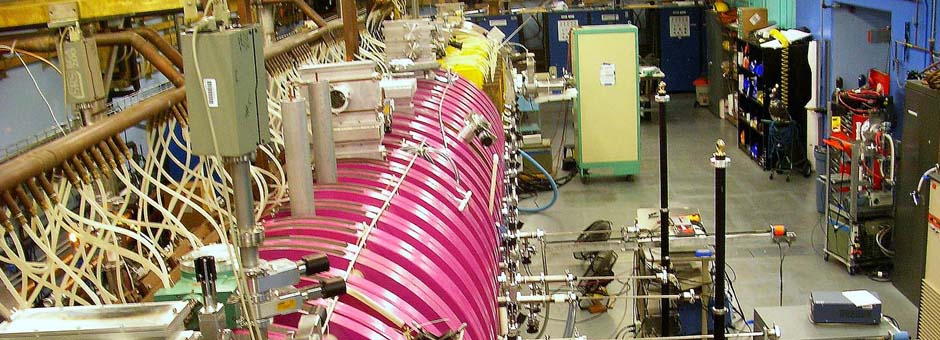
Top-down view of LAPD.
Wave Energy Transport Through the Solar Atmosphere (Hahn-led)
Plasma waves appear to be responsible for much of the heating of the chromosphere, transition region, and corona of the Sun. Fluid motions in the photosphere provide power for the waves, but the precise excitation mechanism is not known. Once excited, the wave energy must be transmitted to the corona. However, recent observations have shown that the interface region between the photosphere and corona (i.e., the chromosphere and transition region) is complex. Thus, it is known how wave energy propagates through the interface region. These issues hinder the development of coronal heating models, which are limited by our poor understanding of the wave properties at the base of the corona.
We will use data from the Interface Region Imaging Spectrometer (IRIS) to measure the properties of waves in the interface region. The objectives are to: (1) identify where plasma waves are generated, (2) determine how wave energy propagates from the photosphere to the corona, and (3) specify the wave boundary conditions at the base of the corona.
Archival IRIS data will be analyzed to address the following three major issues:
First, determine where magnetohydrodynamic (MHD) waves are generated. It is currently unknown whether waves are generated mainly in the photosphere and propagate up through the interface region or whether the waves are generated within the interface region. The photosphere exhibits various fluid motions that can generate waves, such as the buffeting of magnetic field lines by granular motions. But the waves can be reflected by the strong density gradients at the transition region and so not reach the corona. Global acoustic pmodes at the photosphere could launch acoustic waves, but they must undergo mode conversion if they are the source of the Alfvénic waves observed in the corona. Alternatively, waves may be generated in the chromosphere, for example, by reconnection. IRIS data will be used to determine the wave modes and sources and sinks of wave power through varying heights in the interface region and thereby identify signatures of these processes and other possible ones.
Second, measure the propagation of waves from the photosphere into the corona. Wave reflection and damping may prevent much of the wave power from reaching the corona. This project will determine how waves are transmitted through the interface region by observing the propagation of waves along structures and by measuring the power spectrum of the waves. These measurements will then be compared to existing observations and spectra of lower lying photospheric fluctuations and of Alfvénic waves in the higher lying corona. The analysis will determine where Alfvénic waves are reflected, if there is conversion of wave power from longitudinal to transverse modes or vice versa, and where wave energy is dissipated. Results will be compared to theories for the propagation, reflection, and damping of waves throughout this complex region.
Finally, characterize the wave modes and power at the base of the corona in order provide the critical boundary conditions needed for models of coronal heating. By comparing the amplitudes and phases of velocity and intensity fluctuations one can constrain the relative contribution of compressible versus incompressible waves. IRIS has sufficient spatial resolution to see torsional oscillations and thereby estimate the Alfvénic wave energy content of torsional versus kink waves. By studying the power spectrum of the waves, it will be determined whether the fluctuations are already turbulent at the base of the corona or whether the turbulence develops in the corona at larger heights.
This research is supported by NSF grant AGS-1834822. Previous research in this area was supported by NSF grants AGS-1459247 and AGS-1060194. Jump to top
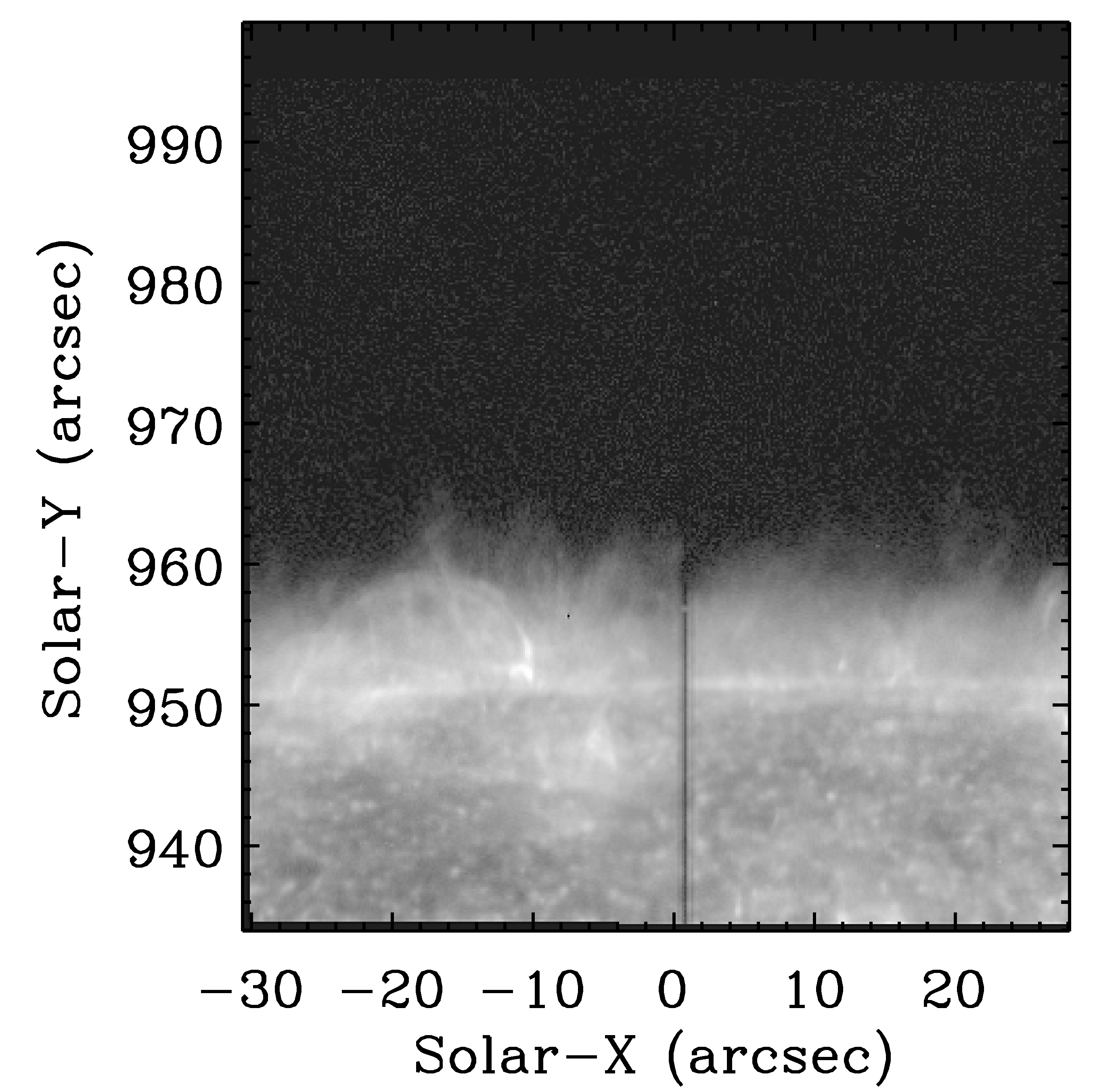
IRIS slit-jaw image in the 1400 Å bandpass from the 2013-09-29 observation at the solar pole. The dark band running down the center of the image is the spectrometer slit.
Solar Wind from Coronal Holes (Hahn-led)
Understanding the solar wind requires determining the source regions for different types of solar wind and the physical processes that accelerate them. We propose to investigate the solar wind from within and near coronal holes (CHs). These open field regions are the source of fast solar wind. Their boundaries are thought to be a source slow solar wind. Theories propose that at CH boundaries reconnection occurs between open and closed magnetic field, releasing stored plasma onto open field lines to form the slow solar wind. Many characteristics of this interchange reconnection process are unknown.
We propose to use elemental abundances as a diagnostic to understand interchange reconnection. The abundances of elements with a low first ionization potential (FIP) grow over time on closed loops. This FIP effect does not occur on open field lines. Thus, the FIP effect can be used to determine how recently a closed field line has undergone reconnection with an open field line. We will study the FIP-effect at the boundaries of CHs and use our results to infer the length and time scales over which interchange reconnection occurs at the CH boundary.
Reconnection is driven by random convective motions and by large scale flows, such as differential rotation. CHs are known to not be sheared by differential rotation of the photosphere. Theories suggest that this is because reconnection at the boundary maintains the CH's shape. We will study differences in the FIP effect gradients on the leading and trailing edges of CHs to determine whether they are consistent with this theory for CH rigid rotation.
A well-known empirical property of the solar wind is the inverse correlation between the wind speed and the expansion factor describing the divergence of magnetic field lines in the low corona. It has been argued that the expansion factor is just a proxy for the solar wind source distance from the coronal hole boundary (DCHB). These different correlations are related to different physics as the expansion factor is important for wave-turbulence driven solar wind models, whereas the DCHB is important for reconnection-driven models.
We will measure the solar-wind outflow velocity at low heights in the corona and determine the correlation between velocity, expansion factor, and DCHB. This will show whether the correlation observed in the solar wind is present at low heights and whether expansion factor/wave-driven models or DCHB/turbulence-driven models are more important.
We will use spectroscopic data from EIS on Hinode, as well as magnetograms and images from SOHO and SDO, to study low latitude CHs. Many suitable public archival datasets already exist. From the EIS data, we will derive the elemental abundances and Doppler velocities and produce maps of these quantities throughout the field of view. We will determine how the FIP effect varies across the CH boundary. We will also study how the abundances vary as a function of latitude at the leading versus trailing edges of the CH in order to observe the effects of differential rotation.
From the magnetograms we will extrapolate the coronal magnetic field using magnetic field models. Potential field models are expected to be sufficiently accurate, but we will use other models to quantify systematic uncertainties. These results will allow us to de-project the line-of-sight velocities to measure the flow velocity along the field. From the model, we will also obtain the expansion factors and find the correlation of flow velocity.
Imaging data will be used to specify the boundary of the CH. In reality, the boundary is gradual and so different conventions and algorithms have been proposed in order to specify a particular location. We will use different conventions in order to quantify systematic uncertainties. Then we will find the correlation between flow velocity and DCHB.
This research is supported by NASA grant 80NSSC20K0183. Previous research in this area was supported by NASA grant NNX15AB71G.
Jump to top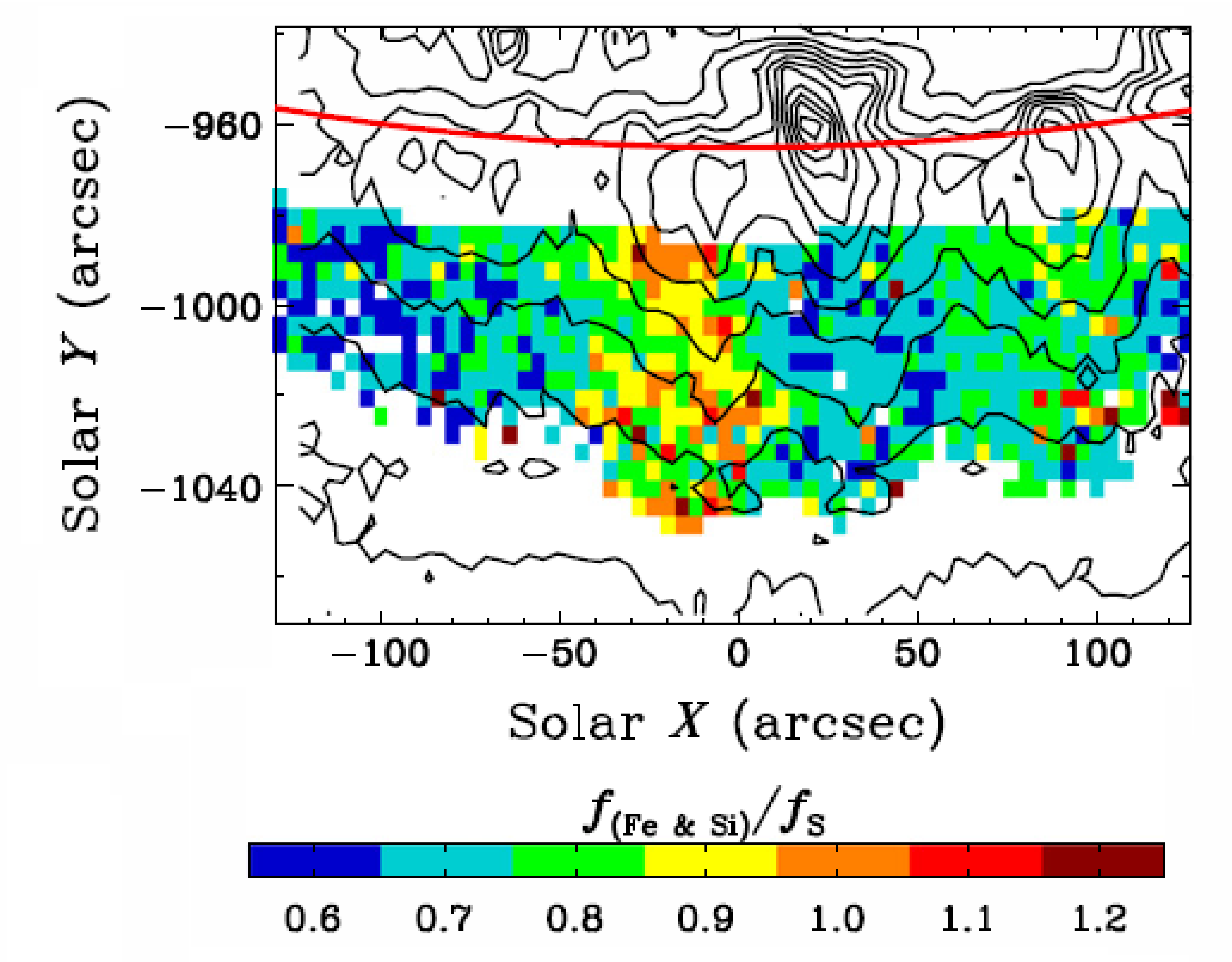
FIP bias of Fe and Si versus S (fFe & Si/fS) in a coronal hole plume. Red line outlines the solar limb. Contours show Fe X intensity for context.
Active Region Heating (Hahn-led)
Our objective is to investigate active region (AR) coronal heating by measuring the anisotropic non-thermal velocities in coronal loops. There are two major theories that explain coronal heating. Wave-turbulence theories consider the heating to be caused by waves that are excited at the footpoints of the loops, travel into the corona, generate turbulence, and dissipate their energy into heat. Nanoflare theories consider convection of the loop footpoints to drive quasistatic motions of coronal field lines, which reconnect and heat the plasma. Existing observational diagnostics do not clearly distinguish between these two types of heating.
We will develop a new diagnostic that can provide unique constraints to help distinguish between heating models. Specifically, we will make the first quantitative measurements of anisotropic non-thermal velocities within AR coronal loops. Spectroscopic line widths in the corona are broader than expected based on temperature alone. The non-thermal broadening is due to unresolved fluid motions, which differ depending on the underlying heating mechanism. Nanoflares generate non-thermal velocities due to the outflow from reconnection jets, while Alfven wave turbulence causes different non-thermal velocities due to turbulent motions. Anisotropic nonthermal velocities are a key observational constraint for the coronal heating mechanism.
We will determine for the first time (1) the magnitudes of the parallel and perpendicular components of the non-thermal velocity in AR loops, (2) estimate their variation along the the loops and (3) determine how the non-thermal velocities correlate with other quantities such as temperature, density, and loop length. We will compare our results to the predictions of heating models.
We will study existing data from Hinode and the Solar Dynamics Observatory (SDO). Both Hinode and SDO are currently operating Heliophysics System Observatory Missions. Their data are publicly available through the NASA Heliophysics Data Portal. The main criteria for choosing observations is that the active region should be near the disk center, where the magnetic data are most reliable. Some potential observations we have identified so far include AR11193 on 2011-04-19, AR11250 on 2011-07-15, and AR12111 on 2014-07-10. More than 15 suitable datasets have already been identified.
We will compare spectroscopic data from EIS on Hinode with magnetic field extrapolations based on data from the HMI and AIA on SDO. From the EIS spectroscopic line profiles we will extract the component of the line broadening along the line of sight (LOS). A novel aspect of our methodology is the determination of the anisotropy in the non-thermal velocity. For this, we need the orientation of the magnetic field. This will be found using the Coronal Modeling System software (CMS). CMS is a state-of-the-art method that extrapolates the coronal magnetic field from HMI data and is also constrained by the observed shapes of sheared coronal loops from AIA images. It reproduces observed loop orientations with high accuracy. From the measured LOS nonthermal velocity and the field line orientation, we will infer the parallel and perpendicular non-thermal velocities.
This research is supported by NASA grant 80NSSC20K0692.
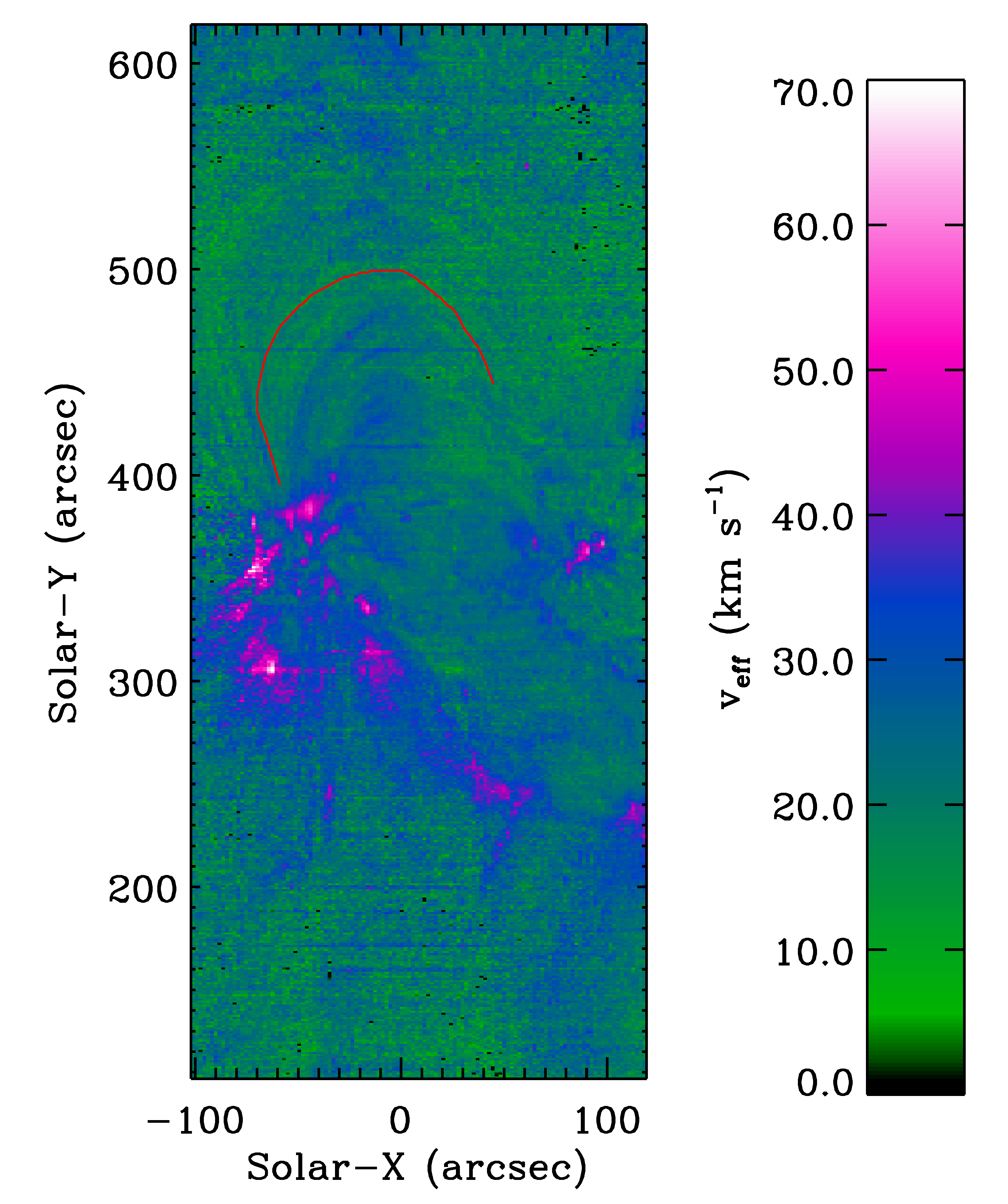
Map of veff derived from the Fe XII 195.12 Å line. The red curve indicates a particular loop selected for study.
Daniel K. Inoyue Solar Telescope Observations (Hahn-led)
Understanding the heating of the solar corona has been a major problem in astrophysics for over 80 years. One theory is that the energy is supplied by Alfvenic plasma waves. Our previous work has provided evidence that supports such wave models, but many details of the Alfvenic waves and their dissipation process have still not been observed. Here, we propose to study novel observations with the DKIST to make the highest resolution measurements to date of Alfvenic waves in the corona. These data will provide details needed for a full theoretical description of wave-heating in the corona.
We will focus on four science questions:
1. What are the characteristics of Alfvenic wave damping in coronal holes? The amplitudes of Alfvenic waves can be measured based on the widths of spectroscopic emission lines. Our previous observations have shown that Alfvenic waves are damped at low heights in coronal holes, but those results have large uncertainties and are also sensitive to instrument scattered light. We will perform new measurements using the Cryo-NIRSP spectrometer on DKIST. These measurements will have greater spectral resolution and thereby provide a more detailed measurement of the wave damping. Using DKIST's coronagraphic capability, we will also have an independent measurement with different scattered light properties compared to our previous work.
2. Where are Alfvenic waves reflected and is this related to density fluctuations? One possible method for damping Alfvenic waves is to first reflect them, so that the outward and inward propagating waves produce a turbulent interaction that leads to dissipation and heating. Density fluctuations have been observed in the corona at similar heights to where the Alfvenic waves are dissipated and might promote wave reflection. We propose to use Cryo-NIRSP observations with DKIST to study the Doppler shift spectra of waves in the corona and identify the locations where Alfvenic waves are reflected.
3. Which Alfvenic wave modes are present in coronal holes? Alfvenic waves in the corona may be in the form of torsional waves or kink waves. For the same wave amplitude, these waves carry significantly different energies. Previous measurements did not have sufficient spatial resolution to determine which wave modes are present in the corona. Using high spatial resolution observations with the DL-NIRSP spectrometer of DKIST, we will be able to study the structure of the Alfvenic waves in the corona and determine which wave modes are present.
4. What is the perpendicular wavelength of the Alfvenic waves? The perpendicular wavelength of the waves describes the transverse length-scale that is affected by the wave. Essentially, it represents the size of the antenna. This is a critical parameter for understanding wave damping. Currently, the perpendicular wavelength is uncertain by many orders of magnitude. Using high spatial resolution DL-NIRSP observations we will make the most accurate measurements yet of the perpendicular length scale of Alfvenic waves.
DKIST is expected to begin operations in 2020 and our work would make for ideal first-light studies. The observations we require do not require precise radiometric or polarimetric calibrations that will be uncertain during DKIST's initial operations. We will also study coronal holes, which are expected to be a prominent feature of the Sun during the current near solar minimum conditions.
This research is supported by NSF Grant AST-2005887.
Jump to top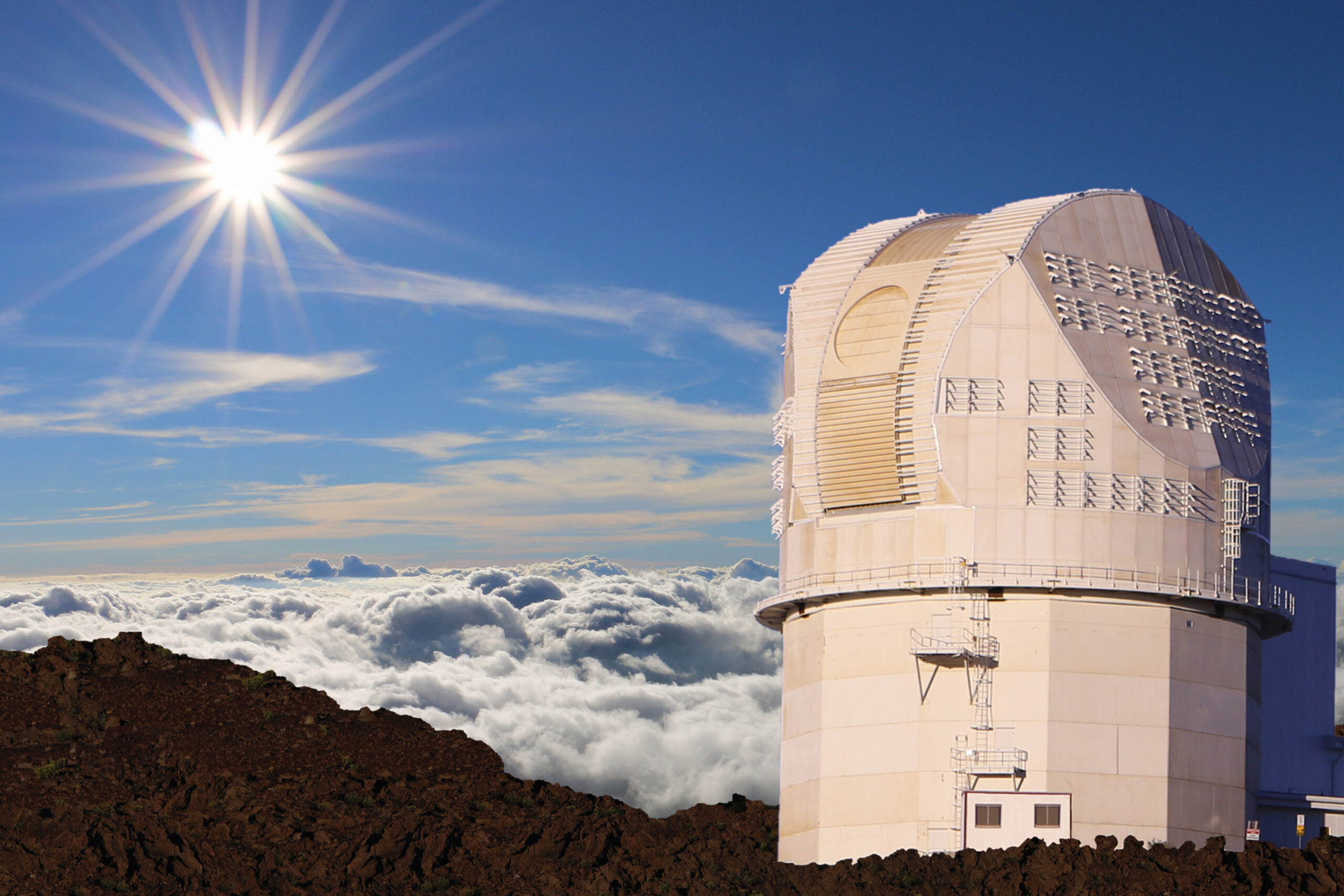
DKIST is located on the summit of Haleakalā on the Hawaiian island of Maui.